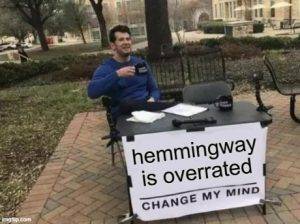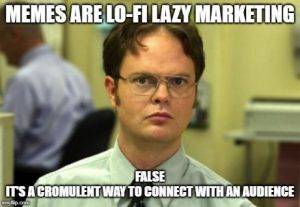
What are memes, what role can they play in your social messaging mix and where do they even come from?
In the beginning there was Richard Dawkins, and all was well. In his 1976 book The Selfish Gene, Dawkins coined a new term for an element that spreads via imitation, a meme. Within biological study this is often considered part of the evolutionary process. In the 1990s a new field of scientific study arose, memetics.
A bird that dances in a certain way, that attracts more mates. Other birds imitate the attraction-by-dance method and adapt it for their own. Which, I suppose, is also true of dancing humans.
The key meme elements are reduplication, reach and adaptation. This applies to any lifeform, moment or social media post.
It’s worth saying up front that the use of memes as part of internet culture has a long history. As with anything people can adapt, usage sometimes drifts into unacceptable territory. One day you’re a feel-good cartoon frog, the next you’re a hate symbol. It’s unfortunate, but we shouldn’t pretend it doesn’t happen, or shy away from talking about it.
But it doesn’t invalidate the meme as a form of expression.
Meme use is rising. A Talkwalker and Hubspot social media study revealed rising meme use amongst 13-35s. More than half (55%) communicate using memes every week. Meanwhile, the wider mentions and recognitions of memes are growing.
Marketing teams know that they should be on the platforms their customers are on. But, they should also engage them in a way that chimes with their usage.
So, the question is: should meme marketing be part of our social media mix? Yes, probably.
While every meme has its instigator, optimal usage is repurposing it for your own needs. The best way to do this is to look at other uses of the meme template. Then, determine what the format does and how you can make it about you, what you want to do or about anything you choose.
Determining the tone of a meme, so that it lands with the audience and represents your brand can be tough. If you go straight for corporate messaging, your audience is likely to see through it. If you go for social commentary, people will object. If you go for something unrelated to the company or its products, someone complains. “Why do such a thing? How does it help us sell sprockets? Posting snarky pictures of SpongeBob SquarePants bemoaning TikTok?”
That’s another thing, should you be including TikTok in your social mix too?

In a nutshell, using memes is about connecting your corporate social account with your audience. When the glamour shot of the new MegaSprocket 5000 comes along, your audience is more likely to see the product post because Facebook, Instagram or whatever other social media platform recognizes that they liked that doge meme you posted last week and will serve them a few more of your posts.
That sentence is very long indeed. Don’t write meme text like that. Less is more. Brevity.
A final consideration for including some meme marketing content is cost. You can create content using a free meme generator online that lets you plug in your text and generate an image. However, these often come with a small watermark.
Watermarking is an issue for each company to decide on, but it plays to the lo-fi internet content feel of meme marketing. This lack of fidelity and ownership of content puts some brands off but these are essential parts of a meme.
Creating early memes required using screengrabs and applying text over whited out areas. Thus, this gave them a messy digital noise feel. They speak to punk aesthetics and the open source ownership of ideas. Instead of spending time creating graphics in Illustrator, you can work through ideas. Consider trying variations until you find the one that’s new and bold and right for you.
Need to get inspired? Consider the following memes for your social media program:

This is a nice and easy starter meme and represents the binary format of many memes. Two contradictory pieces of text align with two images that indicate emotion or attitude.
We’ve used quite a direct corporate message in our example. You should try to be more cultural, to connect with your audience. Use it to comment on popular culture. Or a problem your consumers face that you can solve.
Try to find new ways to use two-part memes beyond the good/bad text format. Then, you can tap into your audience’s sense of the familiar but also offer something new. A good mix.

This is a medium-level meme with some spice.
The original photo showed a campaigner saying male privilege was a myth, sarcastically asking people to change his mind. Initial meme-ing of the photo was a way of mocking him, but has become a way of expressing opinions that get a reaction.
Finding a way to generate interaction on social media platforms is part of the core reason to use a social media platform. Creating comments and reactions tells a platform that the content is interesting to users. This helps you reach new followers and raise your account’s status. This means that next time you post, it’ll end up in front of more people.

One of the most difficult memes to use is the cultural moment meme. It needs to be one your audience knows. It also, as with this Dwight K. Schrute example, requires the writing to match a person or character’s speech. This is particularly true if the audience is likely to be reading the text in the person’s voice.
If you can incorporate the cultural tone of memes like this, then you are a master meme maker.
Memes as part of the social media mix is not for every company. Brand voice is important. Some products and services are niche, or serious enough that placing them alongside memes is never going to work. Additionally, you do not need to give over all your comms to a meme marketing campaign.
But, if you want to target a younger demographic or bring a bit of fun and personality to your social media program, memes are ideal. Growing awareness, without talking product-product-product, helps generate quality interactions with your audience. Then, when you do post product content, your audience is bigger and ready to see what you have.
Need help incorporating some meme marketing into your B2B social media program? We can also help develop fresh ideas that set you apart from your competitors. Contact Mulberry to make your approach to social media more personal.
Mike McConnell is a Creative Lead at Mulberry Marketing Communications. An award-winning full-service B2B communications agency based in Chicago, London and Melbourne. He has years of experience creating and editing written work for a diverse range of clients across multiple formats. His favourite meme is doge. Many clicks. Such wow.